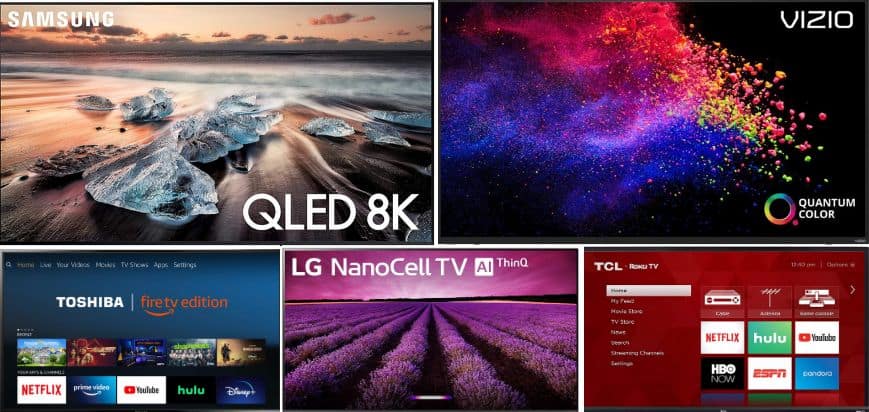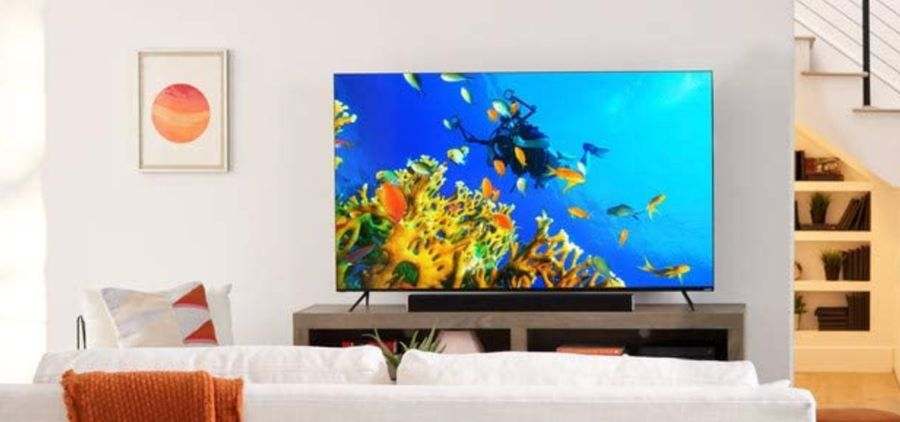
If you are interested in purchasing a smart TV, it can be hard to find the perfect option based on quality and price. Sometimes these factors can be hard to balance, and with so many smart TVs out there, searching for the right one can be overwhelming; they all have similar features, so how can you tell them apart?
Are all smart TVs the same? No. Each smart TV comes with different features and at different price ranges. For that reason, it is incredibly important to know what TV capabilities you’re looking for, and how much you’re willing to pay to get them.
With so many smart TVs to choose from, it can be difficult to get a clear picture of the best among them. Whether you’re a techy or not, this smart TV buyer’s guide and tips will help you find a great smart TV for a reasonable price.
Why All Smart TVs Are Not the Same
According to Tom’s Guide, “There is no standard operating system or interface for smart TVs. Nearly every smart-TV maker uses different software and a different graphical presentation. Some companies use a variety of operating systems and interfaces depending on the model.” This means that not only do smart TVs differ by manufacturer, but they can even vary within a manufacturer’s different models.
A smart TV from, for example, Samsung, will make a TV that might be wildly different from Vizio’s TV. They could have different user interfaces, menus, remotes, plug-in ports, support different apps, and have different capabilities within those apps.
Although most perform similar tasks, such as being able to use the internet and support most major apps like Netflix, the way smart TVs perform these tasks is what differentiates them. Some are optimized with the latest technology, equipped to give you stunning graphics and have every perk available. Of course, this sort of smart TV is in a higher price bracket.
The capabilities of a smart TV go down with the price; however, that doesn’t mean there aren’t quite a few gems in there. It is important to keep in mind that any smart TV will have more built-in capabilities than a regular old TV.
Common Features of a Smart TV: What Makes a Smart TV Smart?

Below is a list of features that are common in quality smart TVs, so you know exactly what to look for:
- Internet Capability: Smart TVs can use Wi-Fi to connect to the internet. This enables them to do many other things like streaming videos or music. Some TVs even have a web-browser where you can actually surf the web like you would on a laptop. Although it may be a little clunky and not as smooth as browsing the web on a laptop would be, it still can be a useful feature to have. (Note: Keep in mind, smart TVs do not have built-in Wi-Fi themselves, but instead can connect to your own pre-existing home Wi-Fi.)
- HD Graphics: Techforluddites.com says, “…Smart TVs will also be HDTVs, but there are many HDTVs that are not Smart TVs.” Because Smart TVs were invented after the technology for HDTVs (high-definition TVs), the vast majority of Smart TVs will use HD graphics to some extent. Some are even capable of 4K and UHD (ultra-high-definition), but you must buy a smart TV specifically made for that.
- Bluetooth and Screencasting: A lot of smart TVs have Bluetooth capability, meaning they can connect to your phone, speakers, computers, Alexa or Google smart devices, and most other things that also have Bluetooth abilities. This enables you to “screencast” to your TV whatever you’re playing or doing on the other device. Oftentimes, people use it to control YouTube or Spotify, or other video and music services. Some smart TVs even have their own phone app that can be used as the TV’s remote control.
- Apps: Most smart TVs have an app store where you can download apps and use them with an interface that was made for display and use on a TV. The most common apps include Netflix, Hulu, YouTube, Prime Video, Spotify, Pandora, and other streaming apps. In fact, some smart TVs have limited, but free, cable apps, so you can watch live TV channels without a cable box.
- Recommendations: Many smart TVs use your search history, watch history, and feedback like favoriting or negatively rating shows to recommend things you might like. This can be a useful system that helps you discover new content that you may end up loving. The great part about recommendation algorithms is that they can be fine-tuned to show the exact things you’re interested in by always trying to give feedback on shows you watch.
- User-Friendly Interface and Remote: A good smart TV will have an interface, menu, and remote that is intuitive and pleasing to the eye. Easy navigation is key, and finding a smart TV with a great user interface (UI) will make an even better experience for you. Product reviews are an excellent place to find information on how navigable a smart TV is.
Differences Between Regular TVs and Smart TVs
| Smart TVs | Regular TVs |
|---|---|
| 1. Are internet accessible through in-home Wi-Fi, but can still function as a normal TV without Wi-Fi 2. Have built-in streaming services and apps 3. Have Bluetooth capabilities 4. Can download movies, shows, and other media 5. Runs like a smartphone on an operating system 6. Compatible with other smart devices like Amazon Alexa and Google Assistant 7. Can potentially have more security and reliability problems | 1. Are generally cheaper than smart TVs 2. Have little to no security issues 3. Will always require cords to connect to other devices 4. Are typically much simpler to operate because they are simpler devices 5. Can gain some functionality of a smart TV using devices like the Roku Streaming Stick or the Amazon Fire TV Stick |
Why Smart TVs are Superior
There are many reasons why smart TVs are not only a great buy, but are also superior to your normal, everyday TV:
- Each smart TV is unique, dependent on its manufacturer. There are endless options out there so that you can find the right fit for you. Everything from highly complicated but extensive functionality to simplistic and basic functionality is available for anyone. You don’t need to be tech-savvy to own, operate, and enjoy a smart TV.
- A smart TV is essentially a TV with a computer built into it. You can surf the web, download, and use apps, stream movies, shows, and live channels, and screencast from your Bluetooth-enabled mobile device. Almost anything a computer can do, a smart TV can do, too.
- Most modern app stores on smart TVs have an incredible range of apps for you to download—some unique to that smart TV’s operating system. Every popular media app you can think of is available on most smart TVs, plus other unique ones like weather apps, sports apps, and even apps that play music to your pets when you’re away from home.
For example, here is a short sample of the different kinds of apps available on Samsung’s Smart TV App Store: Here is a short sample of the different kinds of apps available on Samsung Smart TV’s app store:
- Media Streaming Apps: YouTube, Netflix, Amazon Prime Video, Hulu, Vudu, Disney+, Spotify, PlayStation Now, HBO Go, TMZ, Chef TV, BBC News, College Humor, Google Play Movie and more.
- Sports Apps: WWE Network, UFC.TV, MLB.TV, Fishing TV, Workout Time Recorder, Personal Fit Stretching for Running, and more.
- Information Apps: Web Browser, AccuWeather, PressReader, This Day in History, Did You Know, and more.
- Kids/Educational Apps: Alphabet Games, Best Kids Songs, Fun With Math, Learn & Play, Constellations, Letter Bubbles, Learn French, Solar System Planets, and more.
As you can see, there are plenty of apps to fit anyone’s needs, and this is just for a Samsung Smart TV. Other smart TVs might have different apps to suit your wishes.
Other Benefits of Smart TVs

However, the benefits of smart TVs don’t stop there:
Bluetooth Connectivity
Most smart TVs are also Bluetooth-connected, unlike a regular TV. This is a major pro for smart TVs because that means that any smart home system can be connected to your TV. Smart home systems typically consist of voice-assistant devices like Alexa and Google Home that, once connected, can turn on or off your smart TV, adjust its volume, pull up certain apps, switch the input, change the channel, and many other commands. Essentially you won’t even need a remote!
Another benefit of having Bluetooth capabilities is that you can screencast to your TV. Many apps, like YouTube, for example, let you connect to your TV to choose and cast videos from the app on your phone to the app on the smart TV. It can be so much easier to use your phone to find videos instead of trying to use the TV to type into the search bar.
Convenience
Additionally, a smart TV adds a certain convenience to your life that you might not be able to get elsewhere. All of your favorite apps, movies, shows, music, and news in one spot, on a big screen. Smart TVs are built for big-time streaming, so depending on your internet, you can easily stream with zero buffer time, which is usually a big problem for phones.
Games
Wondering about games? Yes, smart TVs have that too. Although they are simple, they can be fun and easy to play—and are just another thing that normal TVs don’t have. On top of that, apps like PlayStation Now give you the capability of playing console games on your TV. This kind of game-streaming service is relatively new but could be the future of video games.
Social Media
Social media, a favorite pastime of many people, is also accessible on a smart TV. Some TVs have apps to allow you to do this, like Samsung Smart TV’s Social TV app, where you can both browse popular social media sites and communicate with friends while watching videos. However, you don’t really need an app for this. All you need to tune in to social media on your smart TV is its web browser feature, and voila! You have access to all your favorite social media on your big screen.
Security Concerns for Smart TVs
Some naysayers of smart TVs may argue that they aren’t safe devices – indeed, they can be hacked, and get viruses because they are exposed to the internet. This article about smart TV security reports that “any device you connect to the internet can be hacked… it’s up to you to keep your connection secure and be on the lookout for any potential hacker behavior.”
Such behavior could be things like your channel changing on its own without you prompting it to do so, the volume changing itself, or videos you’re playing switching to different ones without your input.
Luckily, you can purchase security software made especially for your smart TV and your internet connection itself. Services like McAfee make security software for smart TVs, and others like Norton also make software for your internet connection.
VPNs, or Virtual Private Networks, are also a great choice as far as personal internet security because they encrypt your online data to protect it from hackers. Click here for more information about VPNs and how they can help protect your personal data.
This all being said, it’s still pretty unlikely that your smart TV will be hacked or get a virus. Just in case, here are two more resources to ensure that you take every step you can to prevent becoming a victim of hacking: Smart TV Security: What You Need To Know, and How to Make Your New Smart TV as Secure as Possible.
The best part about getting a smart TV is that it will still work as a regular TV if you don’t want to use its features. You can still plug in cable boxes, DVD players, Blu-Ray players, or consoles, and use them like you would on a normal TV. No matter how you cut it, a smart TV can fit your needs, depending on if you choose it right.
Top Recommended Smart TVs on the Market

If you’re ready to start your search for a smart TV, the following are some of my personal favorite and best recommended TVs that are making great waves in the market today:
- Samsung QN65Q900RBFXZA QLED 8K Q900 Series
- 8K Ultra UHD Smart TV with HDR and Alexa Compatibility
- AI 8K Upscaling for movies, shows, and streams
- Size: 65 or 55 inches
- Features: Wi-Fi connection, wide viewing angle, works with Alexa and Google Assistant, 8K UHD and HDR 10+, QLED, wall Ambient Mode blends with background
- VIZIO M-Series Quantum 4K HDR Smart TV
- Mirror your iPhone with Apple Airplay, Siri voice control, and Home Kit
- Google Chromecast also built-in, Crisp picture with over 600 nits brightness
- Size: 65 or 55 inches
- Features: Perfect for iPhone users, Dolby Vision HDR, tons of local dimming zones for deep black contrast, work with Alexa and Google Assistant, vibrant new M Series color sets apart from older generations
- LG 65SM8100AUA 4K NanoCell 8 Series
- Apple Airplay Built-in
- Nano Coloring and Quad Core Processor for a super crisp vibrant picture
- Size: 65 inches
- Features: Stream video, pictures, and music from iOS and Mac devices with Airplay built-in, Local Dimming for enhanced contrast, also integrates with Amazon Alexa and Google Assistant with slick LG AI technology
- Toshiba 43LF711U20 4K Amazon Fire TV Edition
- Amazon Fire TV Built-in
- Dolby Vision HDR for enhanced 4K picture
- Size: 43 inches
- Features: Wireless connection, control smart home devices, works with Amazon Alexa with built-in Fire TV, Alexa Voice Remote included, 3 HDMI ports
- TCL 32S327 1080p Roku Smart TV
- Extremely Affordable with Roku built-in
- Snappy 120hz refresh rate is great for Gaming
- Size: 43 or 32 inches
- Features: Headphone jack, works with Alexa and Google Assistant, works with Amazon Alexa with built-in Roku, Roku Remote also included, 3 HDMI ports
How to Choose the Right Smart TV
There are many important factors to keep in mind when choosing your dream smart TV. Probably the most important factor to keep in mind is your budget. How much are you willing or able to spend? Thankfully, the prices of smart TVs have decreased over the past decade, making them mostly very affordable to the average consumer. You can even buy a smart TV, although small and with limited capability, for only a little over $100. However, if you’re looking for the best of the crop with all the possible bells and whistles, there’s a smart TV and a price for that too, usually over $1,000.
Whatever your budget is, find it and stick with it. If anything, be flexible to spend a little more, that way you have no regrets about your purchase.
Next, pick out a size that will fit well with your home. Wherever you intend to put the TV, whether mounting it or setting it on a table, measure out the area, so you don’t overestimate your space or underestimate and are disappointed. Keep in mind that the bigger the screen, the more of an immersive movie-theater experience you can achieve.
Here is a list of most available screen sizes for smart TVs (click here for more useful info on TV sizes):
- Small: 32 inches, 40 inches, 42 inches
- Medium: 50 inches, 55 inches, 60 inches
- Large: 65 inches, 70 inches, 75 inches
- X-Large: 80 inches, 85 inches
The next factor you’ll need to get knowledgeable about is TV resolution, which is the number of pixels displayed on your TV that form the picture (Euronics). As a general rule of thumb, the more pixels, the better the picture will look. There are so many confusing terms when it comes to resolution; it can definitely get overwhelming. CNet has a small cheat sheet that break-downs the most common terms, what they mean, and their pros and cons:
| 720p | 1080p | 4K/UHD | 8K |
|---|---|---|---|
| ∙Roughly 1 million pixels ∙Is the resolution of many 32-inch models | ∙Roughly 2 million pixels ∙Is the typical resolution of 49-inch models and smaller | ∙Roughly 8 million pixels ∙Is the typical resolution of 50-inch models and above | ∙Roughly 33 million pixels ∙Is the typical resolution of the largest models |
However, does the highest resolution always mean the best-looking picture? Not necessarily. If picture quality is a high-ranking factor for you, it is advised instead that you focus on “other aspects of picture quality, such as contrast and color.” A high contrast ratio (meaning deeper blacks and brighter colors) and high-quality color rendering technologies can be much more important than simple resolution.
HDR can also help improve picture quality greatly. HDR stands for “high-dynamic range,” which helps the TV reproduce color realistically and as lifelike as possible. This extra boost to colors in a TV can make a world of difference to any show or movie. If it is possible for you to pay the extra price tag for HDR, it would probably be beneficial.
This leads us to the LED vs. QLED vs. OLED debate, three terms you may have heard before. Let us boil them down for you:
- LED: Stands for light-emitting diode and is the standard of modern TVs. What you need to know about LED TVs is that they are backlit, and can’t achieve complete darkness, hurting the contrast ratio and the deep blacks of the picture. However, if you’re looking for a cheaper option, LED is the one for you.
- QLED: Stands for quantum light-emitting diode and is very similar to normal LED. It uses “nanoparticles called quantum dots to super-charge its brightness and color.” This tech is a step up from LED but is still backlit, and therefore, won’t achieve true black.
- OLED: Stands for organic light-emitting diode and is the improved version of LED. These TVs are not backlit, and instead harnesses incredible pixel-management technology to provide true blacks and amazing picture quality. The pitfall of OLED TVs is the price that comes with the pretty picture, but if you’re willing to pay it, it will be worth it.
Okay, enough with the technical stuff. It’s time to get into the meat of what you’ll really enjoy – the features of the TV that make it a smart TV.
Here is a question for you: what smart features do you want in a smart TV? Do you want voice assistant capabilities? Do you want the TV to have its own mobile app? Do you want to be able to keep up with a football game while you watch a Netflix show? How about the features of the remote? How easy is it to navigate? Does it offer all the apps you want to use and more?
As mentioned at the beginning of this guide, all smart TVs are unique respective to their brands and models. Features differentiate, and you must make a list of the ones you want to find the best fit for you. Our number one tip for this step: Read those reviews. They will be your best insight into what a TV is like to navigate, what its strengths and weaknesses are, and what people loved and hated about it. It’s all crucial to your research for your ideal smart TV.
If you’re still unsure about a certain smart TV you’ve been looking at, seek real-time advice. There are experts in this topic at stores like Best Buy that are trained to help you weigh the pros and cons of products like these so you can make an informed choice. They know all the tech lingo, and they know how to give you the short-version layman’s terms so you can cut through the corporate fancy-speak and see the facts.
Conclusion
I hope this guide helps you while you’re going through the process of buying your perfect smart TV. I know it can be stressful, and it feels like a big investment. Hopefully, these tips can give you some pure purchasing peace of mind.
Smart TVs, smart homes, and smart technologies are the way of the future. Welcome to the smart-tech community!
References:
https://www.digitbin.com/samsung-smart-tv-apps/
https://www.tomsguide.com/us/smart-tv-faq,review-2111.html
Smart TV, 4K, and HDR: What Do They Mean and Do You Need Them?
https://medium.com/@tvgames/the-5-best-games-on-samsung-tizen-smart-tv-fd6b9a48a6a7
https://www.sony.com/electronics/support/articles/00126210
Is my TV watching me? How to know if your smart TV has been hacked
https://lifehacker.com/how-to-make-your-new-smart-tv-as-secure-as-possible-1840178167
TV Resolutions
https://www.rtings.com/tv/reviews/by-size/size-to-distance-relationship
https://www.cnet.com/news/4k-1080p-2k-uhd-8k-tv-resolutions-explained/
https://www.digitaltrends.com/home-theater/qled-vs-oled-tv/
